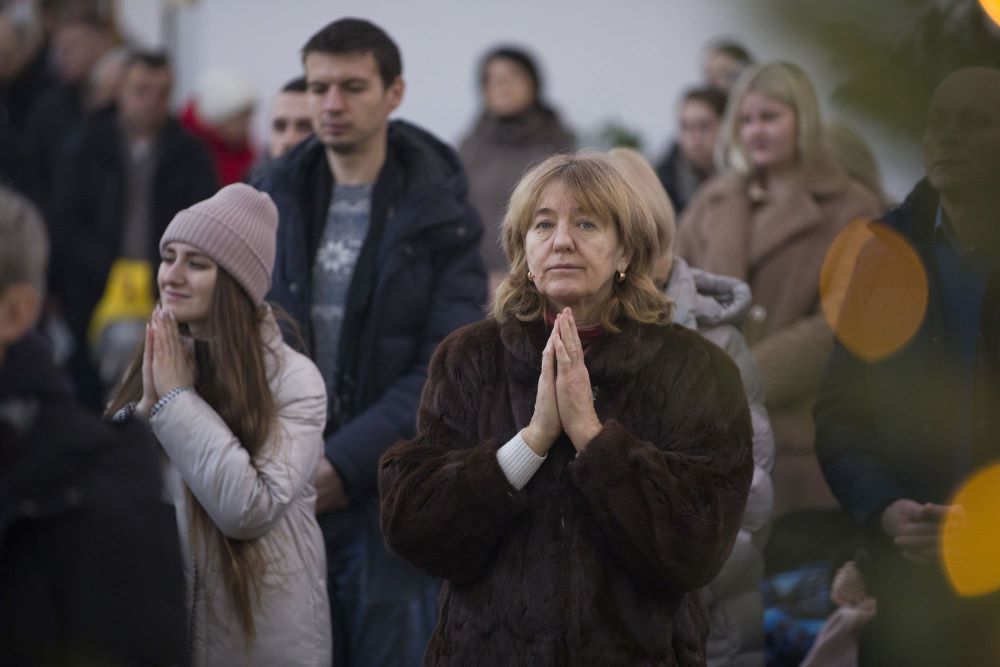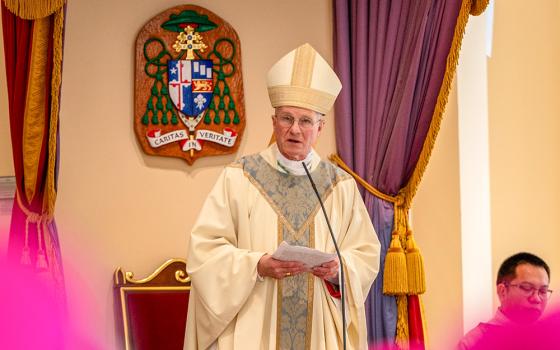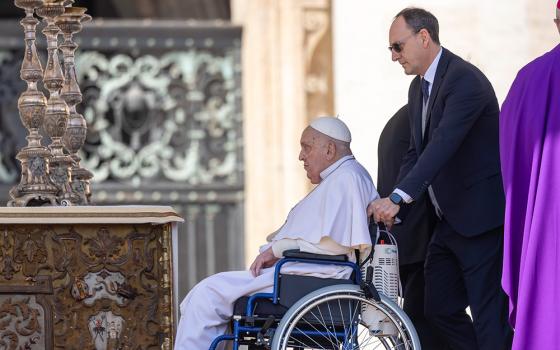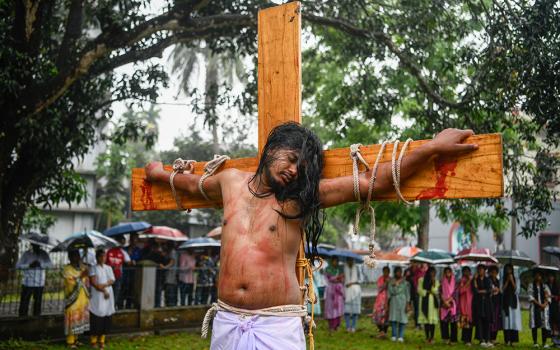People visit a monument to Holodomor victims in Kyiv, Ukraine, Nov. 25, 2023, during a ceremony commemorating the famine of 1932-33, in which millions died of hunger as part of the Kremlin's control over the Republic of Ukraine. (OSV News/Reuters/Sofiia Gatilova)
What analogy would help American Catholics understand the situation in Ukraine?
Perhaps we should think about Ireland.
Like Ukraine, Ireland was dominated for more than 200 years by a huge imperial neighbor. Britain in Ireland. Russia in Ukraine. Both nations disappeared from political maps for more than two centuries.
Ireland got its independence from Britain in 1921 after 230 years of domination. Ukraine was finally free of Russian (Soviet) domination in 1991, after more than nearly 300 years of domination. Ukraine had the added problem of more than one colonial ruler, with Poland and Lithuania and Austria in the west, the Ottoman Turks in the south, and the Russians in the east.
Ukraine is a huge country, with relatively level topography, in the middle of Europe. It has been overrun with invaders since the Mongols invaded in the 13th century from the east. Poland and Lithuania dominated Ukraine in the west. In 1686, the Treaty of Eternal Peace between the Polish/Lithuanian confederation and tsarist Russia divided Ukraine in two, with everything east of the Dnieper River and Kyiv going to the Russians. So, beginning in the 1690s Russia dominated eastern Ukraine. They did their best to eclipse Ukrainian culture and referred condescendingly to Ukrainians and "Little Russians." Even the name "Ukraine" is from the Russian perspective. It means "borderland" — and the border is from Moscow's perspective.
Language is an important part of identity. The indigenous languages of Ireland and Ukraine were both suppressed and supplanted by their colonial rulers. Ireland's educated elite spoke English and were sent to England to study. Ukraine's educated elite spoke the languages of their cultural masters: Polish in the west, Russian in the east. Under the tsars and the Soviets, the elites from Ukraine were sent to Russia to study and were expected to become cultural Russians. Today the Ukrainian language is making a comeback, even in the east. In Ukraine, I've met several Russian-speaking Ukrainians who now refuse to speak the Russian language. And Ukrainian is not a dialect of Russian, any more than Spanish is a dialect of Italian. They are distinct.
Both Irish and Ukrainian cultures were preserved in the rural areas. In the countryside, people spoke their native languages at home, in church and among themselves. But in business and in cities they spoke the language of their colonizers, English and Russian. That seems to have been especially true in Ukraine.
While neither Ireland nor Ukraine governed themselves for more than 200 years, their sons were drafted to fight the wars of their colonizers. The people of both nations generally remained poor, while the agriculture of both nations fed their rulers.
Both nations were visited by unnecessary starvation, despite their rich land and agriculture. Ireland had the Great Hunger of the 19th century, brought on by the potato blight and land rents. It killed a million people and sent another million into exile.
In Ukraine, the breadbasket of Europe, at least 4 million Ukrainians starved to death in the 1930s under Joseph Stalin during the Holodomor ("death by hunger"). It was totally unnecessary, brought on by Stalin's policy of "collectivization" of farming and persecution of Ukraine's Culak farmers, who were perceived as anti-Bolshevik. Russian police entered Ukrainian homes and literally took the food from families.
Eastern Ukraine was severely depopulated by starvation, war and political purges by the end of World War II. Russian speakers were brought in to repopulate eastern Ukraine. (That's similar to what the English did in Northern Ireland when they brought in Scots.) This "Russification" changed the ethnic makeup of eastern Ukraine.
World War II was especially cruel in Ukraine. Between 7 and 8 million Ukrainians died in the war; at least 5 million were civilians. The population of the Ukrainian Soviet Republic was 41 million in 1940 and 36 million people in 1950.

Worshippers pray the blessing of water on the Dnipro River after Major Archbishop Sviatoslav Shevchuk, head of the Ukrainian Greek Catholic Church, celebrated a Divine Liturgy Jan. 6 at the Patriarchal Cathedral of the Resurrection of Christ in Kyiv amid ongoing Russian aggression in Ukraine. (OSV News/Courtesy Ukrainian Greek Catholic Church)
Millions of people have emigrated from both Ireland and Ukraine. After World War II, many Ukrainians came to the U.S. and Canada. The Ukrainian Catholic churches that dot our landscape today are testament to their presence here. A new exodus took place from Ukraine in 2022, when about 6 million people left the country as refugees in just a few months. They settled mostly in western Europe. The population of Ukraine had been 41 million before Russia's full-scale invasion began Feb. 25, 2022. Now it is estimated at about 36 million. (No one is sure because a census is impossible to do in wartime.)
Both Ireland and Ukraine have seen severe religious persecution. In Ireland, the British crown banned Roman Catholicism under Irish penal laws. In Ukraine, under the Soviets, all religion — except Orthodox Christianity under the Moscow patriarch — was banned. The state was officially atheist during the Soviet era, 1921 to 1991. Today, as a result of Russia's invasion, the number of followers of the Ukrainian Orthodox Church of the Moscow Patriarchate is declining and the independent Orthodox Church of Ukraine is growing. Whole parishes are leaving the Moscow patriarch. A July 2022 survey by the Kyiv International Institute of Sociology found only 1 of 25 of Ukrainians (4%) identified with Moscow Patriarchate, a considerable drop from nearly 1 of 5 (18%) in June 2021.
Advertisement
Catholics, of both Eastern and Western rites, saw their churches, seminaries, monasteries, convents, schools and universities seized and closed during the Soviet period. Many church leaders had to go into exile. We visited one formerly Latin Rite church in Lviv, built by Polish Jesuits in the 1700s, which had been a book warehouse under the Soviet regime.
The war seems to have promoted the growth and independence of the Ukrainian Orthodox Church. It was recognized as a self-governing (autocephalous) church only in 2018, by the Patriarch of Constantinople (Istanbul). That resulted in the patriarch of Moscow excommunicating the patriarch of Constantinople.
Why is this important for American Catholics? Because I have heard a fair amount of Russian disinformation from American Catholics after our two visits to Ukraine in the last two years.
People ask: Isn't Ukraine really just part of Russia? Answer: No. Not willingly.
Isn't the Ukrainian language just a dialect of Russian? No. It is a distinct Slavic language.
Wasn't Crimea always Russian? No. Catherine the Great seized it from the Ottoman Turks in 1783. Stalin deported most of the local Tatars to concentration camps in the 1930s.
History matters. It helps us to understand the past and deal with the present.
In 1991 Ukrainians took their rightful place among the peoples of the world. It has been a centuries-long struggle to be free of domination by their imperial neighbors. From what I have seen, they are absolutely determined that they will not again disappear from the maps of the world.






